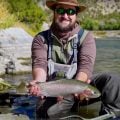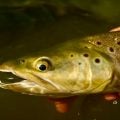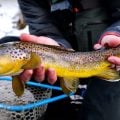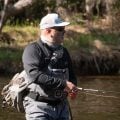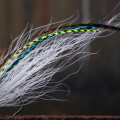Book Excerpt: “Sulphurs,” by Monte Burke
Look, I don’t want to be dismissive of the other great hatches here in the Northeast. I mean, the Quills—the Gordons, the Blues, the Blacks—are really cool flies with names that have an aristocratic gravitas. (A “Mr. Quill Gordon” will have male descendants with “Jr.” and “III” attached to the end of their names. Count on it.) Hendricksons herald the beginning of the season’s fun.
I like March Browns, even though they appear in May. (They were forever called Grey Foxes until some nerdy entomologists got in the way.) It’s nice of the Isonychias to hatch, sporadically, all summer long and into the fall. And the meaty Green and Brown Drakes have a way of sometimes making those prudish big-shouldered browns shed their inhibitions about feeding on the surface. Hell, I even like Tricos, those tiny, trying, midsummer bastards that can drive an otherwise sane man to golf.
But let’s face it. In the East, there is one preeminent mayfly: that white-winged, yellow-bodied beauty known as the sulphur. No other bug on the right coast comes close to its ubiquity. The sulphur plays a part in a nearly perfect, almost Buddhist, continuously looped conditional:
If a stream in the East has trout in it, it more than likely has a sulphur hatch.
If a stream in the East has a sulphur hatch, it more than likely has trout in it.
It’s the staple, maize to Mexicans, rice to Chinese, red wine to Italians, high-fructose corn syrup to Americans. Spell it anyway you please: “sulphur” or “sulfur” or even “sulfer.” The trout don’t give a phuck.
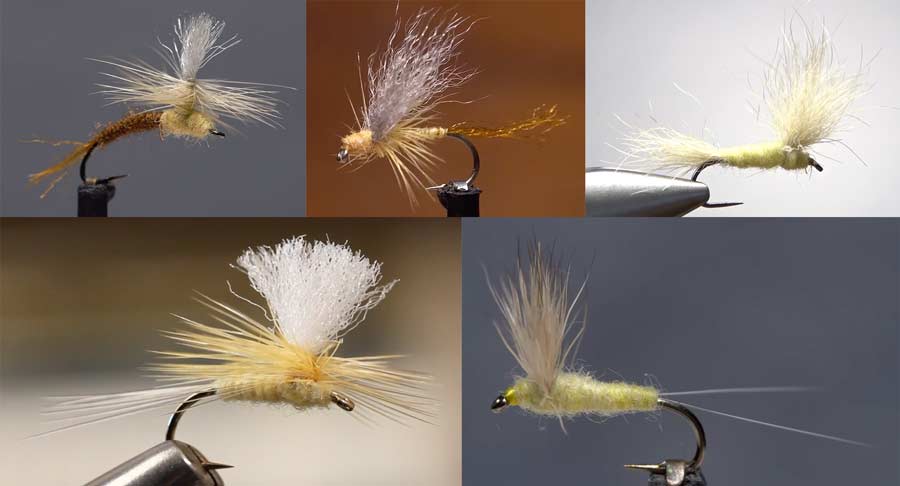
There are many sulphur imitations to choose from (clockwise from upper left): Sulphur Klinkhamer, Sulphur Breadline Emerger, Sulphur Usual, Sulphur Comparadun, and Sulphur Parachute.
In fact, they seem to prefer the sulphur to any other mayfly. On countless evenings I’ve waded the Upper Delaware River and watched literally hundreds of Coffin Flies fall to the water, seemingly bringing every trout in the river to the top. Without fail, I will tie on a size-ten Coffin Fly and make fifty casts that are refused by every nose in the pool before I finally tie on a size-fourteen sulphur, to imitate the concurrent hatch, and finally get some takes. It seems to defy logic: the trout are essentially ignoring an unbutton-the-top-of-your-pants meal for a handful of peanuts. Sulphurs must simply taste better. (I can report from firsthand knowledge that, to humans anyway, they taste like a blade of grass with subtle hints of earwax.)
Familiarity certainly plays a significant role in this dietary decision. Sulphurs begin hatching on the Upper Delaware in the late spring. At dusk, just as the river has begun to darken, the retiring sunlight catches their upright wings just so, making them seem to glow, like cigarette lighters held up during the slow song at a hair band concert. It goes on like this for another three months on this river.
On the Letort Spring Run, the books and charts all say that the meat of the sulphur hatch is in late May and June. Fair enough. But the sulphurs never really seem to stop hatching all year. I’ve fished to a hatch in the welcoming cool of an evening following a brutal hundred-degree August day. A few years ago, I fished a brief but heavy hatch during a snow shower at midday on Christmas Eve.
Sulphurs are incredibly hardy, nearly impervious to the insults of man, a manifestation of the promise of redemption. They are pretty much the only significant mayfly on the ravaged Letort. They were the first mayflies to reappear on both Pennsylvania’s Little Juniata River and Spring Creek after chemical spills killed everything in those waters.
Paul Weamer, the author, fishing guide, and bug dweeb, tells me there are actually two kinds of sulphurs: the “big” sulphur—Ephemerella invaria—and the “little” sulphur—Ephemerella dorothea dorothea (that second dorothea is for those of you who didn’t get it the first time). They are sort of related to Hendricksons (they’re both Ephemerella). But they are not related to Yellow Drakes, Cahills, or Leucrocuta hebes, or to any of the other myriad mayflies that sport a hint of yellow and white, all bugs some obstinate old-timers call “sulphurs” for simplicity’s sake.
It’s all good, though. There’s plenty of room under the sulphur tent for both entomologists with their suitcases of flies hanging from their chests and the generalists who carry only “light” and “dark” flies in sizes 10–18 in a weathered fly wallet. They all catch fish during the reliable, redemptive hatch of the mayfly known as the sulphur.

